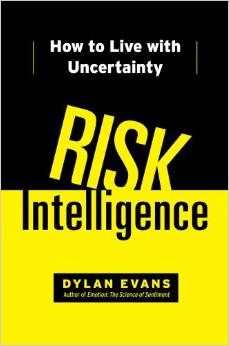Title: Risk Intelligence: How to Live with Uncertainty
Authors: Dylan Evans
ISBN: 978-1451610901

This book was reviewed by David Evans of Burn Bridge Associates.
When senior managers are polled about the greatest challenges that their organisations face, one of the issues that regularly achieves high scores is that of the quality of their people’s decision-making (others, like problem-solving and talent, also perennially appear in such lists). Evans’ book about a concept he terms risk intelligence is therefore something that should be of interest to all those in organisations seeking to gain competitive advantage through their people. As the recent financial crisis demonstrated, living with ambiguity has become a constant, and this book is subtitled “how to live with uncertainty.”
Evans – an eclectic author and academic with psychoanalysis, behavioural science and risk management under his belt – employs mathematics, psychology and his own experience to demonstrate how a risk-intelligence approach to business decision-making provides more balanced and predictable outcomes despite the uncertain environment in which we operate.
Risk intelligence is the ability to estimate probabilities accurately, which means understanding one’s own knowledge-limitations. For people who are risk-intelligent, there is an understanding about when to be confident about their decisions and when to be cautious. Using several examples from business and personal settings, early on in the book, the author draws us into a topic probably regarded by the casual reader as somewhat dry.
The author’s fundamental premise is that we are not able to know everything, and yet too often we make business decisions on a binary basis – go / no go, do / not do decisions. At its core, therefore, this book deals with the assessment of probabilities, which Evans defines as an expression of our ignorance: by quantifying uncertainty we accept we do not have 100% possession of the facts that enable us to make decisions. From this seemingly-straightforward assertion, the author takes us on a wide-ranging journey that covers a number of mathematical and psychological concepts.
Emotional intelligence
He also talks about the role of IQ and – in a link to Daniel Goleman and emotional intelligence – the fact that it does not seem to play a part in all cognitive calculations. He also differentiates between risk intelligence (having “the right amount of certainty” in a given situation) and risk appetite. The latter is an emotional trait that describes how comfortable people are about taking risks. Risk appetite governs how much risk you want to take; whilst risk intelligence involves being aware of how much you are actually taking. Having the first without the second could lead to recklessness or unnecessary caution.
Evans starts the main body of the text with a discussion on the role of experts and the dangers of relying too single-mindedly on experts who have a strong but narrow knowledge of a particular topic. He also shares an online assessment that – he claims – tests for the degree of risk intelligence. What it certainly tests for is the propensity for the respondent to seek certainty: as Evans points out, there is a cultural ‘ambiguity intolerance’ which can lead us to choose binary responses to questions and problems rather than to accept that we may not know and therefore would have to find out more before arriving at an answer.
Whilst reckless disregard of probabilities and options is potentially disastrous for organisations, so too is an overemphasis on the worst-case scenario, claims Evans. He cites several examples: according to him, probability analysis simply does not support the use of the extensive security checks at airports that followed the 9-11 tragedy; and the ‘stranger-danger’ ethos of the 21st century is a vast overreaction by many parents. These may be discomforting examples for many and do present a reasonable “worst-case” thinking approach: for the author, they represent easily-understood examples that can be discussed in the context of rational thinking, evidence-based argumentation and the deployment of probability to offer alternatives.
He also uses a number of well-known psychological concepts to support the need for rational thinking in decision making and asserts that the strengths of an argument are usually given more credence than the credibility of the evidence. Linked to this is confirmation bias, hindsight-ism and groupthink, all of which can hobble our decision-making. Much of our natural internal bias comes from the use of experience to form decisions about current or future actions: not surprisingly, experience is really important and instinctive. Evans argues that there is an inherent problem with this in today’s world: this is because of what he calls the availability heuristic. This refers to the fact that our easy access to all sorts of information may bias our judgement about the probability of events occurring.
The second half of this book gets into the detail of mathematics and in particular Bayesian theories. This is relatively simple to understand, and the author provides a number of examples to explain it to even the most innumerate. This encourages decision-makers to quantify the options in front of them; to make use of experience, in its most objective sense; to load options using the same rules for weighting for each; and, to break problems down into units that themselves can be quantified and assessed objectively.
‘Unknown unknowns’
Toward the end of the book Evans talks about the much-parodied Donald Rumsfeld statement, made on 2002. In his slightly tortuous comment, the then-US defence secretary described a human condition relating to the limits of our knowledge. In mentioning ‘unknown unknowns’ Rumsfeld – perhaps unwittingly – touched on the challenge of decision-making. This author refers to a combination not mentioned by Rumsfeld: he asserts that there are things that we know that we do not necessarily recognise; or at least we do not link known information to problems we face. Understanding the relevance of retained information is perhaps our biggest challenge and our greatest resource.
I found this book fascinating. It is well-written, well-researched and full of great examples and scenarios. At a time when there is an even greater premium than ever on effective decision-making in business, some focus on how we can arrive at better decisions has to be good. However, the challenge that faces us all in decision-making is being able to separate the emotional from the rational and understanding the extent to which one is over-riding the other in our approach. I’m not sure that this author quite addresses this challenge. Evans’ book is compelling for those interested in knowing themselves and their personal decision-making process.
Reviewer’s rating: 3 out of 5






